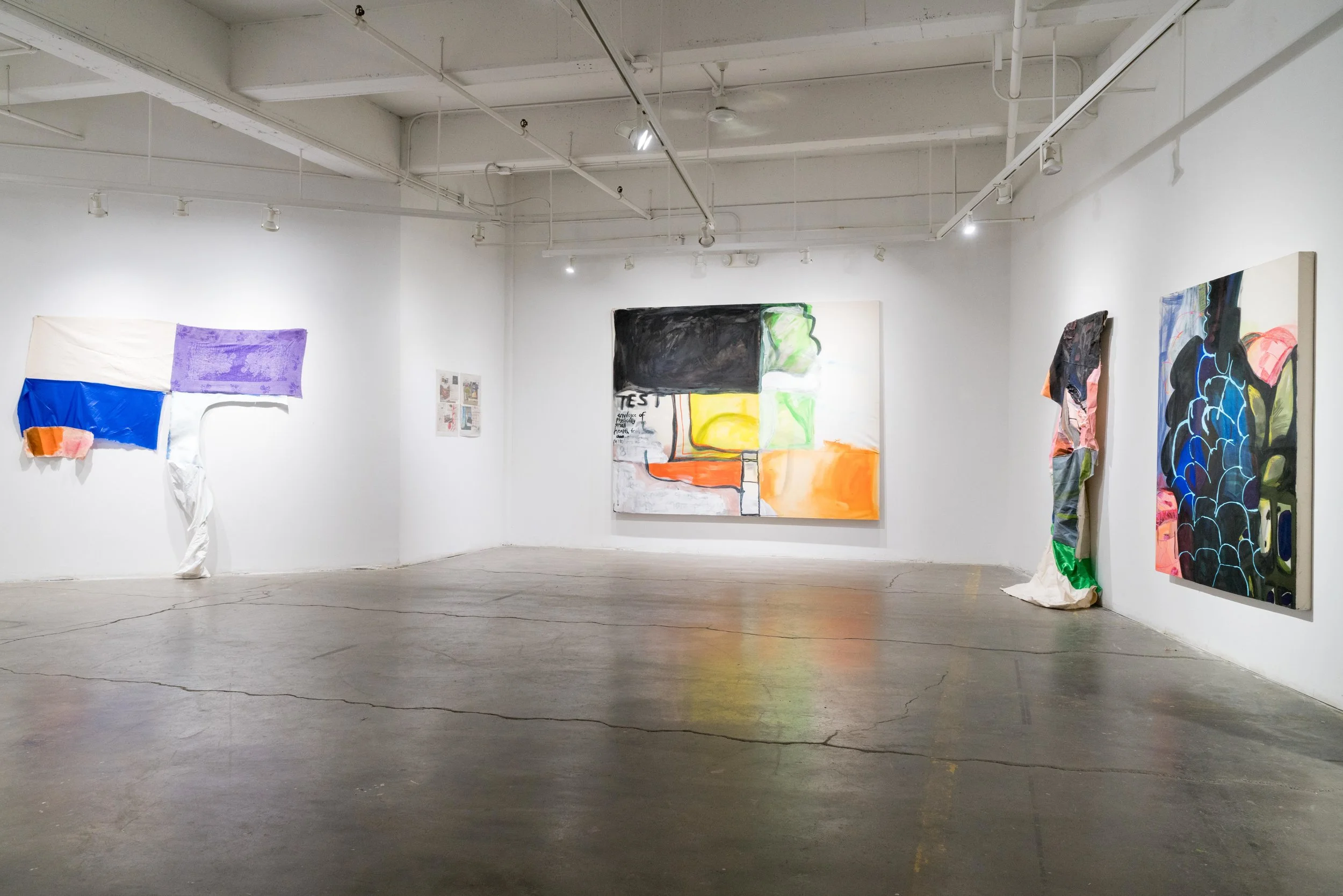REVIEW: Annie Bielski, “Joes & Anns” at Buffalo Arts Studio
04.06.19-05.03.19
Annie Bielski’s exhibition at Buffalo Arts Studio is a highly considered, gnarlily executed group of paintings, wall sculptures, and artists merchandise. Many of the works in the show playfully navigate the spaces between painting and sculpture, trash and fashion, and the monumental and the intimate. They also toe the increasingly blurry line between art and commerce and, sometimes for better and sometimes for worse, fall into a hazy, uncomfortable void between the two.
The first piece one encounters upon entering the exhibition space, a sutured black painting titled Pocket, conjures up both Ad Reinhardt and the sexual bluntness of Courbet’s Origins of the World. Black ink is washed over layers of acrylic color on stitched together canvases that pucker into bodily slits. It sets the stage for the conceptual and material approaches that are echoed throughout the show: cheeky breakdowns of expectations of gender throughout art history, canvases sewn together like clothing, and sophisticated abstract painting.
COWBOY UP FOR Strong Signal Good Base Unit Seek Enjoyment is the only obviously wearable garment on the wall, its title a short poem taken from the text running across two t-shirts ghoulishly connected by a half-open zipper, a sartorial Frankenstein’s monster that references typically masculine endeavors–cowboys riding into the sunset of the American imagination, soldiers hunkered around a HAM radio–which are undercut by touches of pink and peeling roses on a hanger that looks like it was pilfered from the artist’s grandmother’s closet. The rose motif is picked up again in two wall sculptures, Dressed and Maid of the Mist, both constructed from found fabrics and bits of painted canvas. Like PROM on the wall opposite, they are full of expectation and desire, inaccessible but perpetually hoping for a body to fill them.
The visual centerpiece of the exhibition is two pieces of radically different scales. Any Major Issues?? is a newsprint and ink piece that collages iPhone photos together with scanned, hand-written notes covered in paint or scrawled drawings. It sits next to a monumentally-scaled painting titled TEST, the canvas filled with noxious greens, cautionary yellows, and traffic cone orange. Shopping lists, iPhone notes, and to-dos wend their way through these adjacent works, urgent reminders that to paint is also to have to eat and that the artist, far from being closed off from reality, must, out of the sheer necessity of being a body in the world, respond to it, either positively or negatively.
All the Women in my Veins is a blast of bruisy blacks and purples, gloopy organic forms, and sunset orange and salmon underneath a thin lattice of a particularly eye-frying electric blue. Philip Guston’s boots seem to be present here, as are the grotesquely oversized digits of Dana Schutz, and Amy Sillmanesque uses of colors and shapes. Bielski’s paintings are paintings for painters, but their visual and material connections to the rest of the works open up more accessible readings beyond their painterly formalism.
The gift shop at BAS also has several of Bielski’s book editions, including a delightful little photobook with texts by the artist titled NOT FOR HIRE and a series of t-shirt’s turned into cargo shirt “drawings” via the addition of sewn on pockets that “may hold ideas, almonds, cash, ear plugs, poems, garbaggio, and more.” It’s this Clearance body of works that feels the most unresolved. Each shirt is priced at $200 apiece, on permanent clearance for $80. The gesture is a playful stab at notions of value in a hyper-capitalized, hyper-commodified art market and, as the artist’s label states, they are indeed “cheap [for] drawings” and “expensive [for] t-shirts.” But their cost is stickier than they can handle and ultimately situates them pretty squarely in the realm of boutique art objects.
The title of the exhibition sums up the ethos of Bielski’s work elegantly: Joes & Anns is a wink-wink at the material supply chain of craft stores → artist’s studios → exhibition spaces, how kitsch is alchemically transformed into high culture via the artist’s touch; it is a naming tactic that immediately situates the works into a relationship to human scale; and it’s a deadly serious reminder of big issues that have long troubled the art world and the art market: the highly gendered notions that have historically severed the link between “feminine” craft and “masculine” abstract painting.
— Nando Alvarez-Perez
04.21.19

